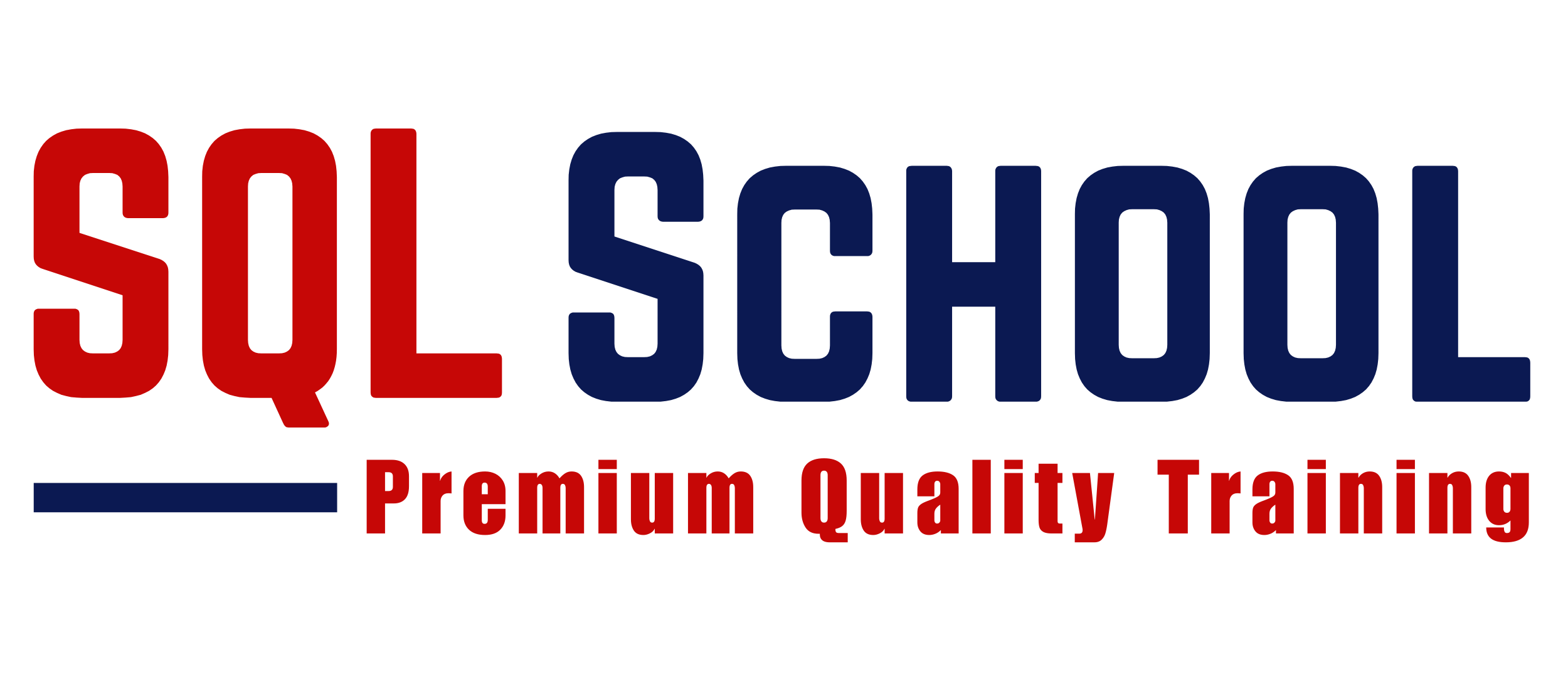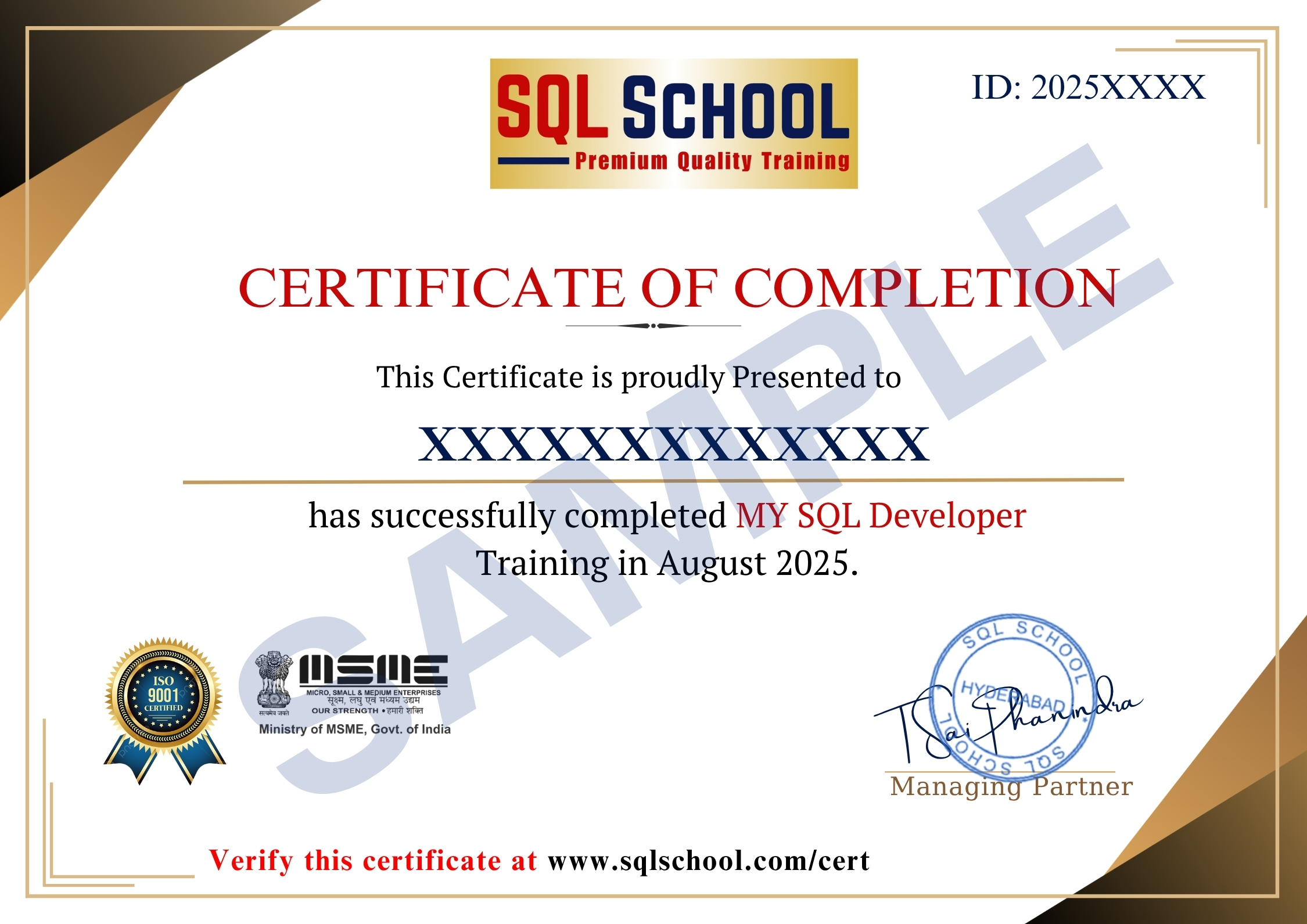
MySQL Developer plays a vital role in designing, developing, and optimizing reliable database systems. They work on schema design, complex queries, stored procedures, and performance tuning to ensure scalability and security. With the growing demand for data-driven applications, learning MySQL offers excellent career opportunities in web development, enterprise solutions, and cloud-based platforms.
✅ SQL Queries, Joins, Subqueries
✅ Stored Procedures & Functions
✅ Triggers, Views & Transactions
✅ Normalization, Database Design
✅ Indexing & Query Optimization
✅ Dynamic SQL & User Variables
✅ JSON, XML Data Handling
✅ Query Tuning Practices
✅ Real-Time PostgreSQL Projects
✅ 1:1 Mentorship & Career Prep
MySQL
Course Contents:
MySQL Developer (Complete Course)
What is Database?; Purpose of Database & Management; Advantages of Database for Data Storage; Introduction to DBMS; Database Design; Most Popular RDBMS Products; History, Real time Database Examples (LIVE); Microsoft SQL, Oracle & MySQL Differences; When to use which?
MySQL Installation Process (step by step); Common Installation Errors & Solutions; MySQL Workbench Installation Concepts & MySQL Command prompt; MySQL Versions and Editions Comparisons; Connect Workbench Developer Tool; Creating a new User; Grant permission; Lock and Unlock User Account;
Structured Query Language (SQL); Data Definition Language (DDL); Data Retrieval Language (DRL); Data Manipulation Language (DML); Transaction Control Language (TCL); Database Security (DCL); Rules of SQL Queries and Statements; Real-world applicative uses of SQL; Creating Users and Tables;
Table Data Inserts; MySQL Data Types; DDL Commands with Examples; CREATE, ALTER, TRUNCATE, DROP, RENAME; DESCRIBE command; DML, DRL Commands Operators; INSERT, UPDATE, DELETE Statements; Truncate & Delete commands; SELECT; SQL Comments; Single Line & Multi Line Comments;
SET, AND, OR, NOT, IN; BETWEEN (NOT BETWEEN); Arithmetic, Logical Operators; Operator Precedence; UNION, UNION ALL, INTERSECT, MINUS; LIKE (NOT LIKE), IS NULL (IS NOT NULL); DCL and TCL;
Identify Distinct Values in Tables; Group & Aggregate function; Group By Operations in Queries; Having Clause; Aggregate Functions with Group By; Order By; Query Execution Order with Group By; Arithmetic Functions, Character Function; Date & Time Functions, String Function; Conversion Functions;
Data Integrity constraints; Domain Integrity Constraints; Entity Integrity Constraints; Referential Integrity Constraints; Check Constraints; NOT NULL, UNIQUE Constraint; PRIMARY KEY and Usage;
FOREIGN KEY Constraints & Relations; Column & Table Constraints; Adding Constraints to Tables, User Constraints ; Enabling – Dropping Constraints, Self Referential Integrity; Disabling Constraints on Tables;
Need for Joins & Table Comparisons; SET Operations; Join Types : Equi Join, Simple Join; Inner Join and Query Conditions; Cross Join (Cartesian Join); Non-Equi Join & Self Join; Outer Joins – Types, Advantages; Cross Joins – Advantages * Limitations; Self Joins, Merge Joins, Sub Queries; Inner Self Joins & HAVING;
VIEWS IN MYSQL, Understanding Views & Use; Relational Views and Standard Views; SIMPLE VIEWS and COMPLEX VIEWS in MYSQL; Column Definitions in VIEWS; Using VIEWS for DML Operations; Forced Views, CHECK Constraints in Views
Sub Queries in Real-world; Dynamic Conditions with Sub Queries; Sub Queries and Nested Sub Queries; How does oracle Execute Nested Sub Queries?; Inner Select and Outer Select Queries; Usage of Sub Queries with WERE, HAVING; Impact of Having Clause in Sub Queries; Select Nth Highest salary; Select Duplicate Records; Delete Duplicate Records; Advantages of MySQL Sub Query
Subquery in the Select Clause; Subquery in the From Clause; Execution of Correlated Sub Queries in SQL; IN, ANY SOME, ALL Operators in Sub Queries; PAIR WISE and NON PAIR WISE in Sub Queries; Single Row Subquery & Multiple Row Subquery; Multiple Column Subquery; Uncorrelated Subquery;
Indexes – Definition & Architecture; B Tree Concept; Clustered and Non clustered Indexes; Primary Key and Clustered Index; Unique Key and Non-Clustered Indexes; Simple Index, Rebuild Index; Materialized Views – Indexed Views; Composite Index, Function Based Index; Range and Hash Partition; List Partition and Composite Partition; Parallel Query Process; Performance Tuning Advantages?;
Simple If, If. Else. Nested If. Else Statements; Ladder, Selection, Simple Case Statements; GOTO Label and EXIT Statements; Iterations, Simple LOOP, WHILE; FOR LOOP and NESTED LOOPS in MYSQL; MYSQL Select statements; Composite Data Types;
Cursor Variables and Management in MYSQL; Implicit & Explicit Cursors and Attributes; Cursor with Parameters and Nested LOOPs; Cursors with Sub Queries, Reference Cursors; Implicit Cursors, Explicit Cursor; Parameterized Cursors, Ref Cursors; MySQL Cursors Usage
Transaction Concepts in Databases with SQL; Transaction Types and Uses; Commit and Rollback Operations; Nested Transactions with Save points; Database Read Consistency with SQL; Creation of READ ONLY VIEWS – Realtime Use; Sequences, with Synonyms; View Vs Synonym in MySQL
Procedures in MYSQL: STORED PROCEDURE; Parameters (IN, OUT, IN OUT); POSITIONAL and NAMED Notation; Procedure with Cursors and Sub Queries; ALTER and DROP of Stored Procedures; Using SPs for Dynamic SQL Statements; Loops and Table Variables in SQL Programs
Functions in MYSQL: Real-time Usage; User Defined Functions, Nested Functions; Using Functions in SQL Statements; Comparing Stored Procedures and Functions; Using SPs with Table Value Functions; Analytical Function; Rank(), Dense_Rank(),Row_Number(); IFNULL() FUNCTION;
Pragma_Autonomous_Transaction() with SPs; Returning into clause, Bulk Collect; For All, Definer/Invoker Rights & Usage; About Flash Back Queries, Dynamic SQL; Flash Back Command, Purge Command; Regular Expressions in MYSQL; Recycle Bin; Delete Recycle Bin Table;
MySQL Triggers: Row Level & Statement Level Triggers; DML Triggers; DDL Triggers and Schema Level Triggers; OLD & NEW References, Trigger Auditing; Enabling / Disabling Triggers, Dropping Triggers; Triggers and Data Manipulations; Memory Tables in Triggers; DML & DDL Events with Triggers; Compound Triggers; Working with LARGE Tables;
SQL SCHOOL
24x7 LIVE Online Server (Lab) with Real-time Databases.
Course includes ONE Real-time Project.
#Top Technologies
Training FAQs
Who is SQL School? How far you have been in the training services ?
SQL School is a registered training institute, established in February 2008 at Hyderabad, India. We offer Real-time trainings and projects including Job Support exclusively on Microsoft SQL Server, T-SQL, SQL Server DBA and MSBI (SSIS, SSAS, SSRS) Courses. All our training services are completely practical and real-time. CREDITS of SQL School Training Center
- We are Microsoft Partner. ID# 4338151
- ISO Certified Training Center
- Completely dedicated to Microsoft SQL Server
- All trainings delivered by our Certified Trainers only
- One of the few institutes consistently delivering the trainings for more than 19+ Years online as inhouse
- Real-time projects in
- Healthcare
- Banking
- Insurance
- Retail Sales
- Telecom
- ECommerce
I registered for the Demo but did not get any response?
Make sure you provide all the required information. Upon Approval, you should be receiving an email containing the information on how to join for the demo session. Approval process usually takes minutes to few hours. Please do monitor your spam emails also.
Why you need our Contact Number and Full Name for Demo/Training Registration?
This is to make sure we are connected to the authenticated / trusted attendees as we need to share our Bank Details / Other Payment Information once you are happy with our Training Procedure and demo session. Your contact information is maintained completely confidential as per our Privacy Policy. Payment Receipt(s) and Course Completion Certificate(s) would be furnished with the same details.
What is the Training Registration & Confirmation Process?
Upon submitting demo registration form and attending LIVE demo session, we need to receive your email confirmation on joining for the training. Only then, payment details would be sent and slot would be allocated subject to availability of seats. We have the required tools for ensuring interactivity and quality of our services.
Please Note: Slot Confirmation Subject to Availability Of Seats.
Will you provide the Software required for the Training and Practice?
Yes, during the free demo session itself.
How am I assured quality of the services?
We have been providing the Trainings – Online, Video and Classroom for the last 19+ years – effectively and efficiently for more than 100000 (1 lakh) students and professionals across USA, India, UK, Australia and other countries. We are dedicated to offer realtime and practical project oriented trainings exclusively on SQL Server and related technologies. We do provide 24×7 Lab and Assistance with Job Support – even after the course! To make sure you are gaining confidence on our trainings, participans are requested to attend for a free LIVE demo based on the schedules posted @ Register. Alternatively, participants may request for video demo by mailing us to contact@sqlschool.com Registration process to take place once you are happy with the demo session. Further, payments accepted in installments (via Paypal / Online Banking) to ensure trusted services from SQL School™
YES, We use Enterprise Edition Evaluation Editions (Full Version with complete feature support valid for SIX months) for our trainings. Software and Installation Guidance would be provided for T-SQL, SQL DBA and MSBI / DW courses.
Why Choose SQL School
- 100% Real-Time and Practical
- ISO 9001:2008 Certified
- Concept wise FAQs
- TWO Real-time Case Studies, One Project
- Weekly Mock Interviews
- 24/7 LIVE Server Access
- Realtime Project FAQs
- Course Completion Certificate
- Placement Assistance
- Job Support
- Realtime Project Solution
- MS Certification Guidance















